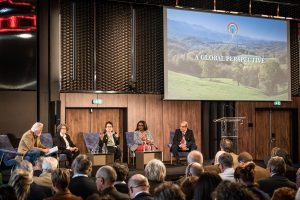
Technical Session I of the 69th General Assembly was Biodiversity 2030: A Global Perspective.
The aim of the session was to identify key issues facing the global conservation community, and the ways in which the CIC could help address them.
Introductory Report
Shane Mahoney, President of CIC Policy and Law Division
Speakers
Ivonne Higuero, Secretary General of CITES and Chair of CPW
Amy Fraenkel, Executive Secretary of CMS
Dr. Musonda Mumba, Secretary General of the Ramsar Convention on Wetlands
Moderator
Sebastian Winkler, Director General of the CIC
Funding for conservation was a common vein of discussion seen throughout the proceedings. With the global needs of biodiversity amounting to $700 billion per annum, fully catering to its needs was stated as a problem that requires addressing going forwards.
In this regard, Ivonne Higuero touched on the importance of private funding for conservation, with governments currently unable to support biodiversity’s needs in full. In particular, such funding can help ensure that the interests of indigenous peoples and local communities are taken into consideration in international policy making processes.
This is an area that the CIC has been actively working on in recent years, having supported the participation of community representatives at the IUCN APAC 2022 and CITES COP19 conferences last year. A motion calling for the creation of an Indigenous Peoples and Local Communities Working Group was later adopted as part of the General Assembly proceedings.
In response, Shane Mahoney noted that the seemingly insurmountable figure of $700 billion is an issue born out of a lack of interest in conservation. A deeper understanding of society itself – its needs and desires – was therefore stressed as a necessity if we are to build towards a more sustainable world.
To achieve this, it was suggested that there will be a need to use concepts such as One Health and the Wild Harvest initiative to communicate our message to wider audiences. It should be noted that the CIC will become the first international partner in the Wild Harvest initiative to scale up their experience in North America to a global level, with particular focus on wildlife economy.
When discussing the role that the sustainable use community could play in supporting the Global Biodiversity Framework (GBF) within the context of migratory birds, Amy Fraenkel listed four key priority areas: : 1) Raising awareness on CMS policies on migratory species and engaging CIC state and national association members in their implementation, 2) Contributing to monitoring and research methods for migratory species, 3) Ensuring community benefits, 4) Building public support for sustainable legal hunting and its contribution to conservation outcomes.
Touching on the very nature of “sustainable use” was Dr. Musonda Mumba, who noted how RAMSAR was created from the ground up with a “wise use” approach, which is defined as the maintenance of ecological character through the implementation of ecosystem approaches, within the context of sustainable development.
Promoting the principles of “wise use” would also be a reflection on our past, with the term already used in 1971 by the CIC members who were a driving force in the establishment of the Ramsar Convention.
Held under the theme Biodiversity 2030: Restore – Rewild – Remind, the 69th CIC General Assembly was among the first international conferences designed to move into implementation of the recently adopted 2030 Global Biodiversity Framework (GBF) and support the UN Decade on Ecosystem Restoration.
Hosted in Paris, France the event was both a reflection back on the organisation’s heritage and a look forward to the future, with its outcomes due to be used to build the 2030 CIC Programme.
Summaries of the other Technical Sessions that took place at the General Assembly can be found below:
Biodiversity 2030: A French Perspective
Biodiversity 2030: A Stakeholder Perspective
